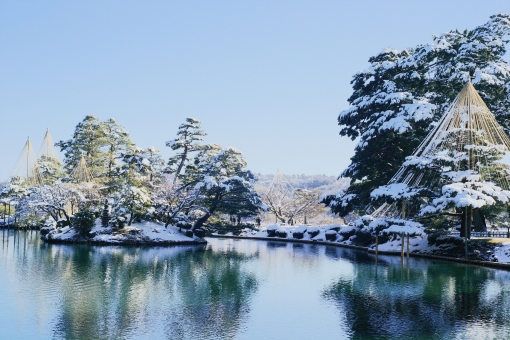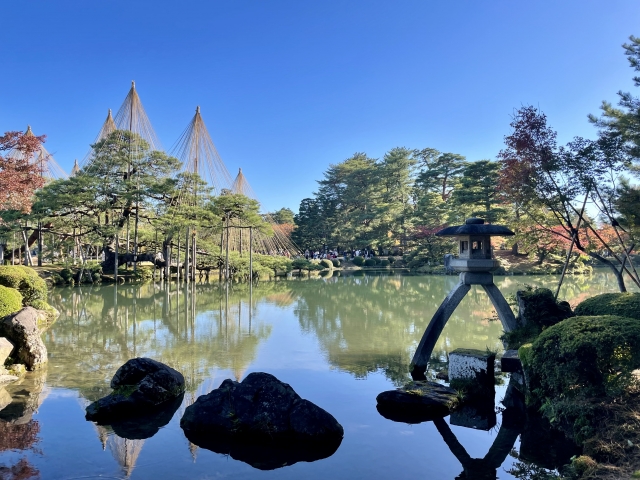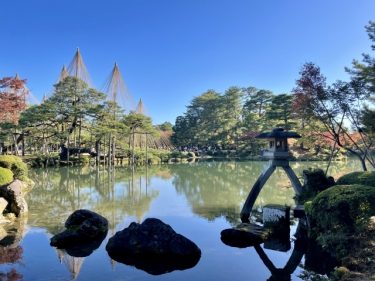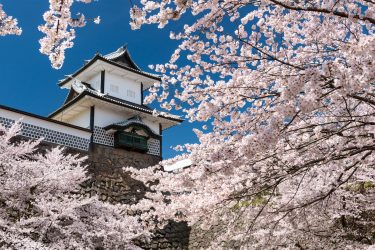What is Kenrokuen? One of Japan’s Three Great Gardens
Kenrokuen, located in Kanazawa City, Ishikawa Prefecture, is renowned as one of Japan’s Three Great Gardens. This garden was created during the mid-Edo period by the Maeda family, rulers of the Kaga Domain, and its vast scale and beauty captivate both domestic and international tourists. The name “Kenrokuen” was given by the Confucian scholar Matsudaira Sadanobu during the Edo period. It comes from six scenic elements mentioned in the Chinese classic “Luoyang Famous Gardens Record”—**”spaciousness,” “seclusion,” “man-made,” “antiquity,” “watercourses,”** and **”panoramic views.”**
Originally, Kenrokuen was developed as a garden adjacent to the outer moat of Kanazawa Castle by the 5th feudal lord, Maeda Tsunanori. Later, during the time of the 13th feudal lord, Maeda Nariyasu, the garden was expanded to its present large-scale layout, with continuous improvements made throughout the Edo period. The garden’s characteristic feature is the harmonious balance between man-made structures and natural landscapes. With large ponds, mountains, waterfalls, and trees, visitors can enjoy the ever-changing seasonal scenery.
In 1964, Kenrokuen was designated a **Special Place of Scenic Beauty** by the Japanese government, acknowledging its historical and cultural significance. It is not just a beautiful garden but a place where visitors can experience Japan’s long-standing garden culture, nurtured over centuries. When visiting Kanazawa, take your time to explore and soak in the seasonal atmosphere at Kenrokuen.

Highlights of Kenrokuen
Kenrokuen is renowned as one of Japan’s Three Great Gardens, with its vast grounds and harmonious blend of nature and man-made structures serving as its main attractions. Visitors are enchanted by the changing seasonal landscapes, with each visit offering a different kind of beauty.
1. Kotoji Lantern
The Kotoji Lantern, a two-legged lantern standing by the pond, is one of the most iconic features of Kenrokuen. Its name comes from its resemblance to the “kotoji,” the bridge supporting the strings of a koto (Japanese harp). The contrast of the lantern with cherry blossoms in spring, autumn leaves, and snow in winter creates breathtaking scenes, and many tourists take photos here.
2. Kasumigaike Pond
Kasumigaike is the largest pond in Kenrokuen, located at the heart of the garden. Famous sites such as Karasaki Pine, Kotoji Lantern, and Horai Island are arranged around the pond, and the reflection of these features in the water offers ever-changing views throughout the seasons. The snow-covered scenery during winter is especially enchanting and draws visitors with its ethereal beauty.
3. Karasaki Pine
This black pine, transplanted from the famous “Karasaki Pine” in Omi (present-day Shiga Prefecture), stands with its impressive branches spread wide. During winter, the tree is protected with traditional **”yukitsuri” (snow support)** ropes, a sight that symbolizes winter in Kanazawa.
4. Neagarimatsu (Raised-root Pine)
Another iconic feature of Kenrokuen is the Neagarimatsu, a pine tree with roots rising 2 meters above the ground. The tree’s impressive 40-plus roots create a unique and striking sight. It was originally planted as a young tree and, after growing, the soil around it was removed to expose its roots.
5. Kyokusui Stream and Niji-bashi (Rainbow Bridge)
Kyokusui is a natural stream running through the garden, offering a peaceful spot for visitors. Niji-bashi, an arched stone bridge over the stream, is another scenic spot, with its reflection in the water beautifully contrasting with the changing seasons.
6. Plum Grove and Cherry Blossom Trees
In spring, over 200 plum trees of about 20 varieties bloom in the plum grove, while the cherry blossom grove boasts over 40 types of cherry trees. The cherry blossom season is especially popular, with the entire garden turning pink as the trees come into full bloom.
Thus, Kenrokuen is a place where you can immerse yourself in Japan’s traditional beauty, with its stunning natural landscapes harmonizing with historical architecture.
Seasonal Highlights of Kenrokuen
Kenrokuen is famous for its breathtaking scenery throughout the year, with each season offering its own unique charm. Below are the highlights for each season:
Spring: The Beautiful Sight of Cherry and Plum Blossoms
In spring, Kenrokuen is adorned with cherry and plum blossoms in full bloom. Over 400 cherry trees of about 40 varieties are planted throughout the garden, including Somei Yoshino, wild cherry, and chrysanthemum cherry blossoms. The chrysanthemum cherry, in particular, is notable for its abundant petals, captivating visitors. Plum trees also begin to bloom from late February, signaling the arrival of spring with their beautiful flowers. Spring is a popular time for visitors, and strolling through the garden under the soft spring sunlight is a truly delightful experience.
Summer: Refreshing Greenery and Water Features
During summer, Kenrokuen is enveloped in vibrant green foliage. The streams and Kasumigaike Pond provide a cool respite for visitors. In the evening, you might even catch a glimpse of fireflies dancing in the night air, adding to the garden’s magical atmosphere. The view of Kasumigaike from the Kotoji Lantern is especially striking, with the clear blue sky and lush greenery reflected on the water’s surface, offering a refreshing sight unique to summer.
Autumn: The Vivid Colors of the Changing Leaves
In autumn, Kenrokuen is transformed into a kaleidoscope of colors as the leaves turn brilliant shades of red and yellow. The sight of the trees, bridges, and ponds against the vibrant autumn foliage is breathtaking. A special light-up event is held in autumn, during which the garden is illuminated at night, creating a fantastical atmosphere. The evening to nighttime transition showcases a different charm from daytime, providing visitors with a unique experience.
Winter: Snow-Supported Trees and Serene Snow-Covered Landscapes
In winter, Kenrokuen is transformed into a white wonderland, with wet snow typical of the Sea of Japan region covering the landscape. The iconic Karasaki Pine, supported by **yukitsuri** ropes, is a symbol of Kanazawa’s winter. The yukitsuri structures, designed to protect trees from the heavy snow, add to the unique winter scenery, making Kenrokuen even more captivating. During the winter light-up event, the snow-covered garden is bathed in golden light, offering a serene and otherworldly beauty that is quite different from the daytime scenes.
Kenrokuen offers a different experience in each season, from the vibrant flowers of spring to the tranquil snowscapes of winter. It’s a garden that invites you to visit again and again, each time revealing a new side of its natural beauty and historical landscapes.

Access to Kenrokuen and Time Required
Kenrokuen is located in the heart of Kanazawa City, making it highly accessible for tourists. Public transportation or car are convenient ways to get there.
The most common way to access the garden is by bus from Kanazawa Station. Frequent buses to “Kenrokuen-shita” or “Kanazawa Castle Park/Kenrokuen Entrance” take about 15-20 minutes. Tourists can choose between the “Kanazawa Loop Bus,” which offers routes in both clockwise and counterclockwise directions, or the regular city buses. A one-day pass for the loop bus costs 500 yen and allows unlimited rides, making it an efficient way to visit multiple attractions.
Walking is also an option. Kenrokuen is about 2.5 kilometers from Kanazawa Station, taking around 30-40 minutes on foot. The walk passes through scenic spots in Kanazawa City, including Omicho Market and Kanazawa Castle Park, allowing for a leisurely stroll while taking in the local sights.
For those traveling by car, the garden is about a 10-15 minute drive from Kanazawa Station. There are several paid parking lots near Kenrokuen, with the “Ishikawa Kenrokuen Parking Lot” being particularly convenient due to its proximity to the garden entrance. During peak tourist seasons, early arrival is recommended to secure parking.
Kenrokuen’s proximity to other tourist attractions adds to its appeal. Kanazawa Castle Park and the 21st Century Museum of Contemporary Art are adjacent to Kenrokuen and easily accessible on foot. In particular, Kanazawa Castle Park is only a 2-3 minute walk away, making it convenient to combine these attractions into a single sightseeing plan.
A visit to Kenrokuen typically takes about 1-2 hours, allowing for a relaxed stroll through the garden while taking photographs and enjoying the scenery. The garden’s seasonal beauty—whether the cherry blossoms in spring, the autumn leaves, or the snow-laden yukitsuri in winter—ensures that visitors can enjoy its charms year-round.





